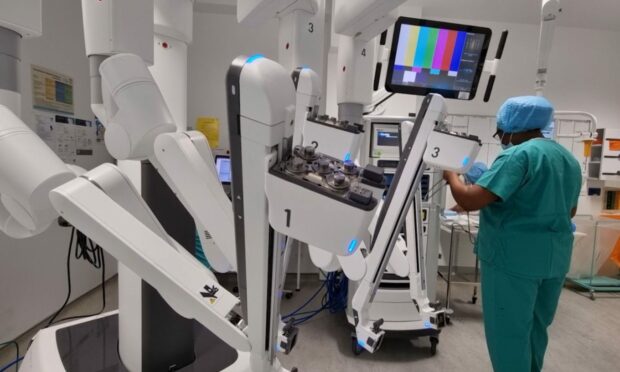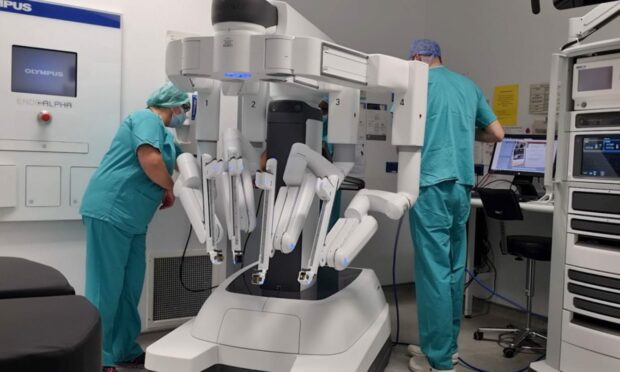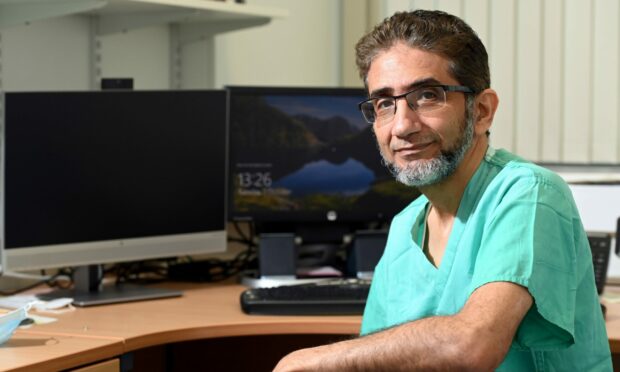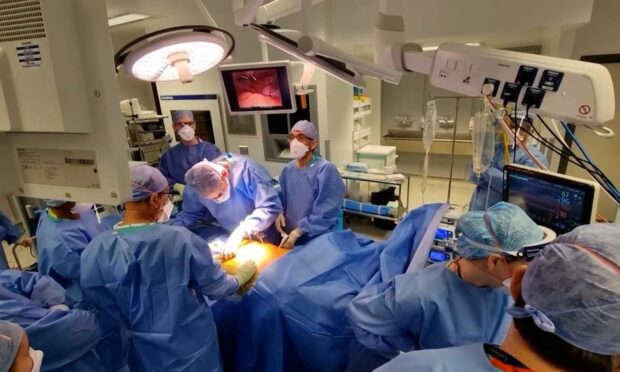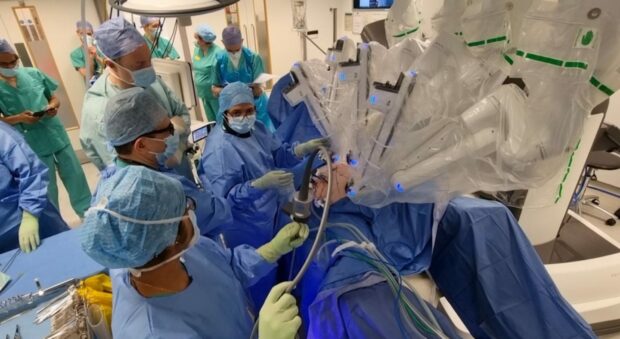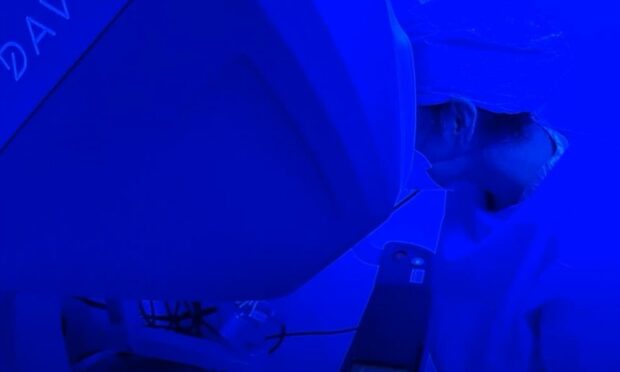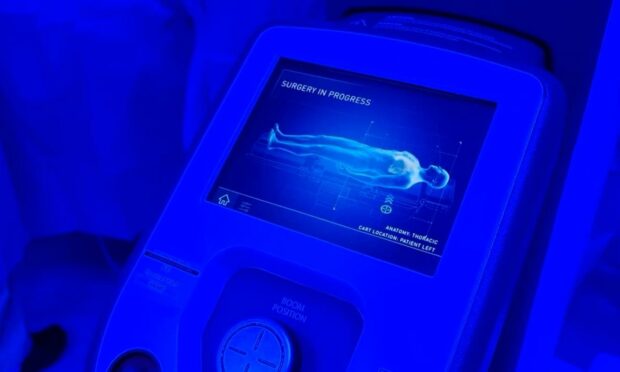I don’t consider myself a particularly squeamish person.
So, when I was asked if I’d be interested in sitting in during a robotics-assisted surgery, the first thing that popped in my mind wasn’t needles, incisions, and blood.
Instead, something in the back of head chirped up and asked: “Robot surgery? What’s that?”
It immediately conjured up an image of a futuristic society, just like the one in Disney’s animated film Wall-E.
Naïve and unsure of what to expect, but curious nonetheless, I agreed.
No chance I would be turning down the opportunity to witness a surgery—no less a robot surgery.
‘What is a thymus?’
The day of the surgery, NHS Grampian’s corporate communications officer Gary Cruden led me to the early morning huddle at Aberdeen Royal Infirmary.
Here staff work out how many beds are available based on upcoming surgeries, what patients have been admitted and which beds are already taken.
It didn’t take me long to understand that bed availability is scarce, and the less time patients spend in HDU, or in the ward, the better for the running of the hospital.
From there, I was introduced to Mohammed Wesam Khalil, a consultant cardiothoracic surgeon who would be performing the procedure.
Mr Khalil explained what type of surgery I would be seeing and it was the first time I’d ever heard of the thymus.
When no one was looking, I whipped out my phone to brush up on my anatomy by typing “what is the thymus?” on Google. (It’s a gland near the heart that produces disease-fighting cells.)
The surgery is not performed by a robot
Bit by bit, with more information, Mr Khalil was able to explain what robotic-assisted surgery entailed.
First and foremost, it was not a surgery performed by an independent robot— and it bears repeating.
Instead, he would be the one controlling the arms of the robot, sitting at a machine where he could view inside the patient’s body through a high-definition screen, mere feet away from the patient.
My understanding is that robotic systems were originally meant to be used for long-distance trauma surgery in battlefield settings.
Given the possibility of remote surgery, I wondered if we’ll ever hear of the day of an Aberdeen surgeon performing a procedure on someone in Elgin.
Shock at recovery
Around Ward 216, I noticed patients in recovery taking slow walks. Patients that had visible long scars down their chests.
Which is why I was shocked when I met Henry Lyons, who just the day before had the top third of his right lung removed through a procedure with the Da Vinci XI robot.
He was sitting up, talking and describing his recovery experience.
After speaking to him, and leaving the ward to get ready to get into theatre, I turned to Gary and said: “I guess if I had the option, I would also pick the robotic surgery.”
The recovery seemed less painful, and the chance to get home quicker.
So, what was it like?
‘What was it like?’
It was the most common question asked by my friends outside of the medical field.
Quite honestly? It was like watching a high-definition, realistic video game, but one where the stakes are extremely high and there’s no “restart” button.
Maybe they were expecting some medical drama experience, straight from the writers room of Grey’s Anatomy. A surgery where tensions were running high due to some external conflict.
But it was nothing like that.
The surgical team were professional, every day folk who were trying to get on with their day and do their jobs right. And, worth mentioning, very friendly and accommodating.
They checked on me, asked if I was okay and if I got to do this sort of stuff often (fingers crossed), and if I was squeamish.
Like some medical version of Honey, I Shrunk The Kids
During the surgery, I got the opportunity to sit at one of the consoles (thankfully, offline). However, the camera inside the patient relayed the footage and I could watch the surgery through Mr Khalil’s eyes.
Staring into the binoculars of the machine, I watched the surgeon resect and later remove sections he had cut. One of the benefits of these types of procedures is the ability to be up close with the medical issue.
To me, it almost felt like I was inside the patient’s chest in a very medical version of Honey, I Shrunk The Kids.
It was clear from watching Mr Kahlil’s handiwork that even though the robot assisted with precision, flexibility and control, his previous training and skills were critical for the success of the procedure.
All in all, it was exciting to witness first hand and extremely up close and personal how medical practices are evolving for the better.
The real revolution is the shrinking waiting times
I think I was meant to walk away wowed by watching a surgery in real time— and I was!
But the image that I keep conjuring up now when I think robotics-assisted surgery isn’t so much the shiny tech.
It’s Mr Lyons sitting up and talking, one day post-op and hopeful to get home early. I think about the morning huddle and the NHS staff breathing a sigh of relief when patients like Mr Lyons get to go home much earlier than anticipated.
I’d like to extend my gratitude to NHS Grampian Corporate Communications for affording me the opportunity to learn more about robotic surgery, James Findlay and Henry Lyons for patiently answering my questions, and to Mr Khalil and the surgical staff at ARI for welcoming me into their theatre.
Thank you for allowing me to be the first journalist NHS Grampian has invited to witness this revolutionary piece of medical equipment in real time.
A title I’m tempted to get engraved on a championship belt to tout about.
